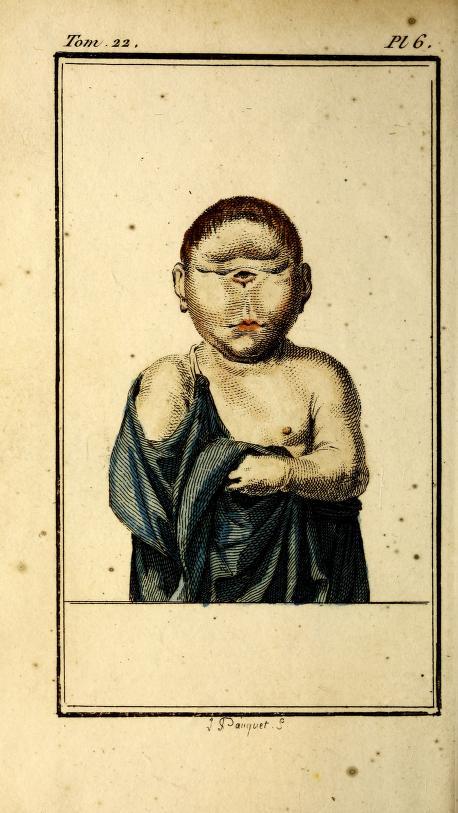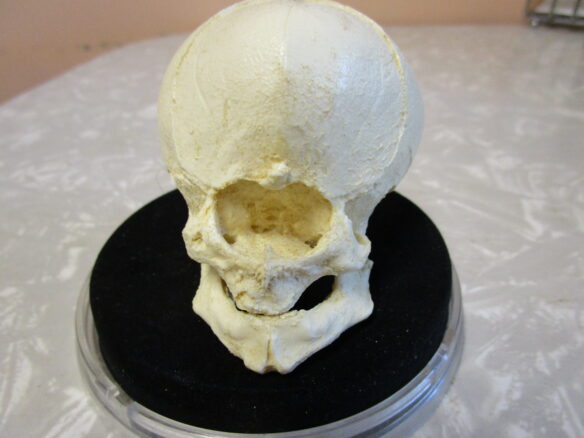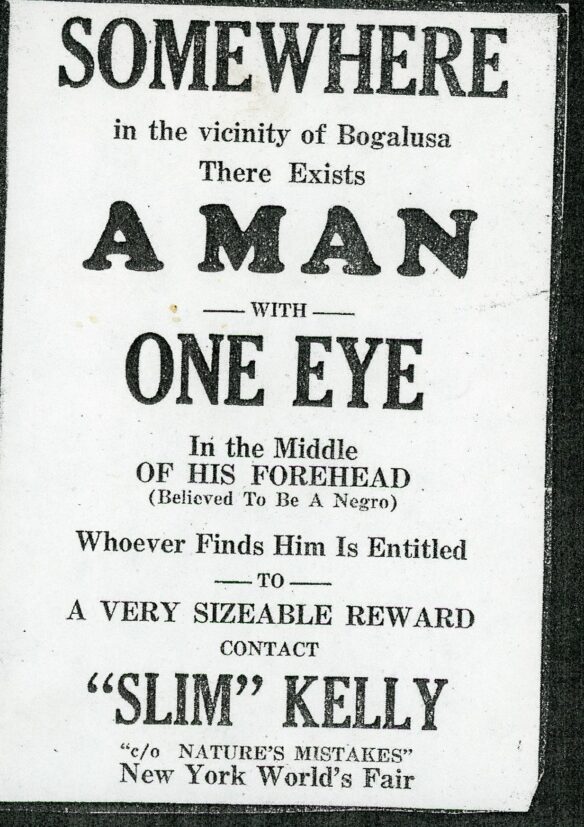By Lee Weinstein:
Step right up ladies and gentlemen, and for the price of one thin dime, see the living, breathing human cyclops, born just the way you see him, like Polyphemus of old!
The eye of the cyclops; the image of the single, symmetrical, central eye, has pervaded popular culture since ancient times. Accounts of one-eyed people stretch from ancient myths and legends to modern fantasy fiction. Cyclopes (plural) have been a staple of science fiction and horror movies, comic books and cartoons, generally used as a metaphor for the strange, alien, and often, dangerous. On the light-hearted side, though, the live-action opening sequence of the syndicated TV series Monsters, (1988-1991) features a cyclopic mother and daughter watching their TV set, and cyclopes appear in such animated cartoons as Futurama (1999-2003), Monsters, Inc. (2001), and Minions (2015). The depictions are usually anatomically incorrect, with a large central eye in the forehead above the nose, or even as a single disembodied eye, as in Tolkien’s depiction of Sauron. Aside from myths, legends and fiction, there have even been reports in modern times of alleged human cyclopes living well past infancy, as we shall see.



One of the earliest examples is the single-eyed giant, Polyphemus, who threatens Odysseus in The Odyssey and its various retellings. Hesiod, a contemporary of Homer, (c 700 BCE) wrote of three cyclopic brothers who fashioned thunderbolts for Zeus.
It has been hypothesized that fossilized mammoth skulls, with a large nasal opening that resembles a large central eye socket, were, in part, an inspiration for these myths.
The Greek historian Herodotus (484-425 BCE) mentions a cyclopic race, called the Arimaspi, in northern Scythia, which was north of Iran and would correspond to parts of Russia and Ukraine today.
Herodotus recounts how the one-eyed Arimaspi were at war with the griffins, who guarded the gold of the region. He obtained the tale from a poem by the semi-legendary Greek poet Aristeas (circa 700 BCE), which only survives today as a few short fragments. Aristeas allegedly traveled north to the Issedones and was told by the people there that yet further north were the Arimaspi, the gold-hoarding griffins and finally the Hyperboreans, but according to Herodotus, Aristeas did not actually travel to these latter places.
Pliny the Elder, noted for his encyclopedic Natural History (77 CE), repeats this story along with descriptions of other rather imaginative races, such as the people with one central leg and a huge foot that they used as an umbrella.
In more recent times, the story of the Arimaspi and their war with the griffins was retold in the YA novel Beyond the North Wind (1993) by American author, Gillian Bradshaw, with Aristeas as the protagonist who endeavors to protect the griffins.
There is also an account of a one-eyed race in The Travels of Sir John Mandeville, alongside descriptions of races of people with the one large umbrella foot, headless races with their faces in their chests, and other such oddities evidently derived from Pliny. The Mandeville book, once believed to be a genuine travelogue, was actually a hoax written in the 14th century by an unknown author. Modeled on such real travelogues as that of Marco Polo, the author, incorporating aspects of the Greek myths, relates, that on an unnamed island somewhere south of Java are a race of giants who have one eye “in the middle of the front” and eat raw flesh and fish.
Then are world-wide references in fairy tales, such as the Grimm’s tale about the three sisters, One-Eye, Two-Eyes, and Three-Eyes. Two-Eyes, like Cinderella, being the normal one, is constantly abused and demeaned by her freakish sisters.
In the modern era, in chapter one of Edgar Rice Burroughs’s second Barsoom novel, Gods of Mars (1913), John Carter encounters cyclopic Plant Men in the northern regions of Mars. They are described as having mouths in their hands, “a single eye,” a hole for a nose and no mouth. The titular gem in the unintentionally hilarous epic, The Eye of Argon, (1970) occupies the central eye socket of a religious idol.
More often, such one-eyed aliens have made their appearance in films and comic books.
Clever use is made of such an alien in a 1963 episode of The Outer Limits titled “O.B.I.T.”
This alien is bent on undermining our social fabric by introducing a machine that can enable people to spy on one another anywhere at any time. The alien’s single central eye can be seen as a metaphor for the all-seeing screen of the spy devices.
These various depictions suggest that belief in living human cyclopes has persisted in different forms over the centuries. Have such people ever existed? Where did the idea originate? Are mammoth skulls a sufficient explanation?
It is a medical fact that babies with one central eye have been born. The condition, called cyclopia, occurs in one out of every 100,000 births, but most are stillborn, or die shortly after birth. Could one occasionally survive?
One persistent account is the intriguing item, “The Child Cyclops,” in Robert L. Ripley’s first Believe It or Not book (1929). The illustration depicts a little girl with bangs and a hairdo framing a face with a single central eye above her nose. Ripley identifies her as the “famous Clement Child,” says she was born in 1793 in Tourcoing, France, was “perfectly normal in every other way,” and lived to the age of fifteen.

Ripley boasted that he could prove every statement he made, and this story has been repeated as true in numerous sources in the years since. He cited volume two of Buffon’s Natural History, as his source. While majoring in biology, I located an edition of Buffon’s work in a campus library. It is a multi-volume encyclopedia representing the life work of the count Georges LeClerc Buffon, whose work in natural history was a major influence the science of biology for many generations to come. There have been various editions and reprints and the volume numbers are not always consistent with the original content, but there is a long section in an early volume entitled “de l’homme” (of mankind) including several pages subtitled “Sur les Monstres” (on monsters), in which he outlines a classification of “monstrous births.” Accompanying woodcuts illustrate a pair of conjoined twins, a piebald child, and, yes, a cyclopic child. However, the accompanying text, translated from the French, tells us that the female infant pictured was born in October, 1766 and lived only a few hours. In fact, the alleged Clement child’s birth in 1793 postdates Buffon’s death in 1788 by five years. Buffon’s work was continued after his death by others, but by scanning online digital versions of the work, I have found no evidence of any other accounts of cyclopic children added later. The posthumus additions to the work chiefly concern the natural history of fish and reptiles.
Babies born with cyclopia, as previously noted, are typically either stillborn or live only for a very short time, usually only a matter of hours, as in Buffon’s case. The condition is the result of a primary failure of the fetal forebrain to divide into right and left hemispheres. This undivided brain produces a single optic nerve rather than two, which forms a single central eyeball. The surrounding tissues of the head develop into one centrally placed eye socket, which blocks the formation of a nose and nasal cavity. This is a fatal blow to these infants, who are unable to breathe while feeding.

In the extremely rare cases where the hemispheres fail to divide, but the face develops normally with two eyes, the child rarely may survive for a time, but such children are afflicted with microcephaly, profound mental deficiency, constant seizures, muscle spasticity, irregular breathing, and poor body temperature control. Some of this is due to the fact that midline defects in the brain interfere with the development of the hypothalamus, which has a critical role in, among other things, regulation of temperature, sleep, hunger and thirst.
Cyclopia can result from multiple causes including genetic and environmental factors. But whatever the cause, the development of the brain is severely compromised.
Anomalies and Curiosities of Medicine (1895), Gould and Pyle’s encyclopedic collection of examples of extreme human anomalies, does not list the Clement Child. The longest lived case of cyclopia they cite lived for only 73 hours.
More recent examples reported in medical journals include a baby born in 1960 who lived for eight days, and another one, with two adjacent central eyes and a single optic nerve, listed in the Opthalmic Registry, Armed Forces Institute of Pathology, who lived for an incredible 28 days. No further information was available.
The usual depiction of a cyclops as seen in the Ripley cartoon, representations of Polyphemus, or the character Leela in the animated Futurama TV series, show the central eye above the bridge of the nose. In actual cyclopic fetuses and newborns, if there is a nose present, it is in the form of a non-functional tubular snout which forms above the eye. Slightly more realistic is Odilon Redon’s painting of Polyphemus, The Cyclops (circa 1914), which displays no nose at all.
It is likely that cyclopic fetuses were a primary inspiration behind such legends as the Arismaspi, which may, in turn, have influenced modern day science fiction and fantasy stories and films. That many mythical creatures bear a resemblance to birth defects is probably not coincidental. Thus, the two-faced god Janus resembles a type of conjoined twinning in which the heads are fused into one and there are two faces on opposite sides of the head. Mermaids resemble siren fetuses, another midline fetal defect in which the legs of the fetus fail to separate, resulting in a central limb resembling a fish’s tail. Legendary races of tailed men correspond to babies born with a vestigial tail. It seems likely, then, that legends of cyclopic races may have been influenced by the occasional birth of cyclopic fetuses.
It is safe to say that the girl depicted by Ripley could not have existed as pictured and could not have lived to the age of 15, let alone having been “perfectly normal in every other way.”
But I have never been able to find a single reference to this “famous” child predating the Ripley cartoon, and not for the lack of trying. Because Ripley claimed he could prove any statement he made, there must have been source material that was possibly somehow misinterpreted.
Ripley’s report of a living human cyclops is not unique. Other reports of such people have appeared occasionally and taken on a life of their own.
There is the tale of an adult cyclops, an African-American man, who allegedly worked as a logger in the turpentine forests of Louisiana. I first came across this story in William Lindsay Gresham’s book, Monster Midway (1953). According to Gresham, he was pursued by the sideshow entrepreneur, Slim Kelly, who wanted him as an attraction but was never able to catch up to the elusive man. While the idea of a human cyclops living to adulthood is totally implausible, a variation of the story appeared in Strange People (1961) by Frank Edwards, differing in some of the details, but obviously based on the same individual. In this version, the cyclopic African-American was living in a backwoods community in Mississippi and spent his life avoiding promoters and showmen. An acquaintance involved in sideshow lore told me he had read somewhere that the story had been made up by Kelly, himself, but was unable to remember where.
Some years later, I came across a photo of an ad in the book Circus and Carnival Ballyhoo (2010) by A.W. Stencell. The ad reads, ”Somewhere in the vicinity of Bogalusa [Louisiana] there exists a man with one eye in the middle of his forehead (believed to be a Negro.) Whoever finds him is entitled to a very sizable reward. Contact “Slim” Kelly ℅ Nature’s Mistakes. New York World’s Fair.” This referred to the 1939 New York World’s Fair and was obviously the source for Gresham’s and Edwards’s accounts.

I contacted Mr. Stencell, who, in turn, put me in touch with Bob Blackmar of the Sideshow Newsletter. Blackmar kindly emailed me an issue containing an article about Slim Kelly and his hunt for the cyclopic man. The article, an interview with Kelly, was reprinted from the October 11th, 1940 issue of Sideshow World. Kelly is quoted as saying “[the cyclops] was roaming through Louisiana with a bunch of roustabouts … he was kind of shy and some of his friends sort of sheltered him from the curious. I was right on his trail in Shreveport and a couple of other places, and then he disappeared somewhere near Bogalusa.”
Blackmar also sent along an interview with Kelly from the New York Daily Mirror August 6, 1940, which included a reproduction of the ad I had first seen in Stencell’s book. Under the ad, Kelly is quoted as saying “I ran this ad in a Louisiana paper … a lot of people down there swore this one-eyed man had been seen often, but he was shy and hard to find. You often find your best acts in the backwoods like that.”
Blackmar in a private communication referred to such interviews and press releases as” BS” and ”puffery.” This supported my initial correspondent’s idea that the story had been cooked up by Kelly, himself. At the time Kelly was co-owner of the “Nature’s Mistakes” show at the 1939 -1940 New York World’s Fair.
Somewhat more plausible-sounding were references in several textbooks on ophthalmology briefly alluding to a cyclopic child who lived to be ten years of age. I traced these references back to a 1908 German reference book (Graefe-Saemish Handbook of the Eye) and specifically to a paper in it by the noted German ophthalmologist Eugen von Hippel, a pioneer in corneal transplantation among other things. In “The Malformations and Congenital Defects of the Eye,” Dr. von Hippel makes the remarkable statement that while cyclopic infants tend to die in the perinatal period, there were cases that lived to the ages of 6 weeks, 18 months, and 10 years, respectively. He footnotes this to two sources, by Dr. Matthew Schon and Dr. P.L.Panum. I have, with the help of a German dictionary, and with acquaintances fluent in German, determined that neither of these sources contained such references.
I have been informed by friends fluent in German that von Hippel’s sentence is actually speculative in tone. A librarian friend translated it as “it is said that there were cases that lived to the ages of 6 weeks…etc.” It is not clear why he cited Schon and Panum’s papers.
The paper by Panum is mainly about conjoined twinning, and mentions, in passing, cases in which the heads are fused and there is a central eye between the normal eyes.
The title of Schon’s book, translated from the German, is Handbook of the Pathological Anatomy of the Human Eye (1828). The one relevant passage in it reads, “only one case is known where a cyclops of the male sex became ten months old.” That caught my attention, as no cyclopes to date have been documented as living more than a month. However, further searching revealed his source, Diseases of the Eyeball, (1769) by Jean-Joseph Guerin, which contains a note in Latin from the author Borrinchius in volume one of the Journal of Copenhagen. I was told by a librarian, who translated the note from the Latin, that age in Europe at that time was reckoned from conception rather than birth and a newborn infant was therefore considered to be nine or ten months old. I corresponded briefly with doctor specializing in medical genetics, who confirmed that it was referring to a newborn. Borrinchius describes the cyclopic newborn as “…a male infant about 10 months, it had no nose; & at the place where its root was to be, it had a round orbit which contained a well shaped eye…”
The cyclops man of Louisiana was evidently a deliberate hoax, and the medical journal account of the ten year old was likely the result of a misunderstanding. But what of Ripley’s “famous” Clement child? I had queried Edward Meyer, then archivist at Ripley International, and he told me that the material in the 1929 book was never sold to Ripley International when Ripley became syndicated by King Features and was likely lost to posterity.
Having discovered, while researching another project, that the oft-repeated cases of the “four-eyed man of Cricklade” and two-faced “Edward Mordake” both originated in an 1894 newspaper hoax, I reasoned that the Clement Child may have had a similar origin. Newspaper hoaxes were quite popular in the late 19th century.
The researcher who provided Ripley with much of his material was a man named Norbert Pearlroth who spent all day every day in the New York Public Library searching for odd facts for Ripley. I tried accessing the newspaper databases at New York Public Library, but to no avail. I even contacted Pearlroth’s grandson via email. He told me he had an old trunk in storage that had belonged to his grandfather. It sounded promising. However, when he checked the contents, it contained nothing relevant.
I decided to cross-check an equally unlikely Ripley story from the same volume. This one was about Jean-Baptiste Mouron, allegedly a French prisoner who was condemned to be a galley slave for 100 years and a day. When his ship was taken out of service, he was kept chained to his bench, in the ship’s bowels. He supposedly lived to be finally set free at the age of 117 years. The reader is referred to an autobiographical account by another Frenchman who was a galley slave during the same period for 17 years. There is no mention of M. Mouron. It occurred to me that the source was cited merely to verify that men were condemned to be galley slaves there at that time period. It then followed that Buffon’s encyclopedia was cited similarly to verify the fact that cyclopic children actually exist, albeit briefly
While the databases in New York turned up nothing, I gave it one more go with the databases in the Free Library of Philadelphia. I never found a reference to the Clement child, but I did turn up something equally interesting.
I discovered an article titled “A Human Curio” which appeared in the Pendleton East Oregonian and was copied by several papers including Chicago’s Daily Inter Ocean for November 27, 1889.
It reads: “Not long ago there was seen in Pendleton a human freak which knocks the spots off any living skeleton or Chinese giant as a natural curiosity. It was an Indian child of the Nez Perce tribe with but one eye, situated in the center of its forehead like those of the fabled Cyclops. The child was able to see with ease and ran about with as much freedom as any of its two-eyed companions.”
The article goes on to say that some local parties were about to negotiate to secure the child when the Indians left for the mountains on a hunting expedition. The mother of the child explained that she had looked at a “one-eyed cayuse” shortly before the infant’s birth.”
A distant cousin of the Clement child, perhaps? “Cayuse” is an archaic term for a small, low-quality horse. The mother (or rather the journalist) is invoking the now obsolete theory of “maternal impression;” that a pregnant woman’s experiences can “mark” a developing fetus. Thus, also in the 1880’s, the famed Elephant Man believed his condition was the result of his mother having been frightened by an elephant while pregnant. Strangely, or perhaps not so strangely, the news item was never followed up. Newspaper hoaxes rarely were.
Read more by the author at https://leestein2003.wordpress.com/
Discover more from File 770
Subscribe to get the latest posts to your email.

Cyclops
I used to go to rounds when I was consulting at the Ante-Natal Testing Unit at Jefferson. At one rounds, they showed ultrasounds of a fetus with one eye and the nose above the eye. Not compatible with life of course. And pretty hard to look at. (At medical rounds they frown on barfing and other sub-professional responses to images.)